|
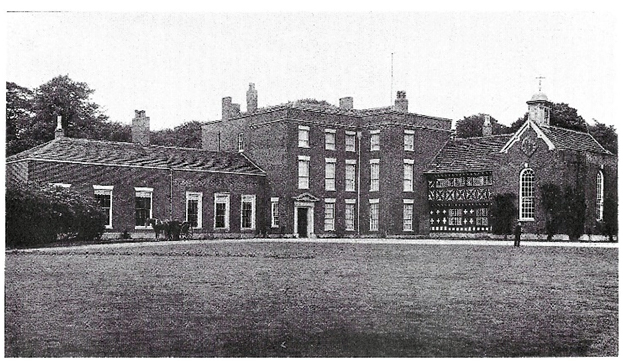 Standish Hall in 1920 - Tudor wing and Chapel on the right.
Standish Hall in 1920 - Tudor wing and Chapel on the right. |
When Henry Standish died in 1920 he had no heirs. He was the last Lord of the Manor. The estate was put up for sale and Standish Hall partly demolished. The once beautiful Manor House on the slopes of the Douglas Valley had the Tudor wing and chapel pulled down and the remains of the house made into two smaller homes. They were demolished in the 1980s when the Coal Board took ownership of the land.
For nearly one hundred years people have been trying to solve the mystery of what happened to the parts that were removed in the 1920s. Stories grew in later years that the chapel and Tudor wing had been rebuilt in America. Were these true or was it the valuable interiors that had been shipped across the Atlantic to be reassembled? Now four ancient rooms from the Hall have been tracked down. Three have been found in America and one in England.
The Standish name has a prominent part in American history. Myles Standish was the military adviser onboard the Mayflower. He became an important member of the Plymouth Colony who were credited with founding modern America. Although his origins remain unclear there was great interest in anything with a Standish connection when the estate went up for sale.
The Daily Mail reported in 1922 that fireplaces and oak panelling from the Hall had been sold to Robersons of Knightsbridge. They were dealers who specialised in selling manor house interiors to wealthy clients. But where did the rooms go from there?
One man who spent years trying to track down parts of Standish Hall was Norman Standish. An American directly descended from Myles. In 1987 he gave a talk at the Standish Festival. He told of how, after years of searching, he got a call to say a wealthy couple living in Detroit had a wood panelled room from Standish Hall in their home. He travelled to Detroit and persuaded the couple to let him see the room. He opened the door to find a beautiful walnut panelled room. His heart sank. He knew the rooms from Standish Hall were oak. He may have been closer than he knew.
In the 1920s Robersons set up an exhibition hall in Knightsbridge where they reconstructed oak panelled rooms for potential buyers to view. The most ornate and valuable rooms from Standish were sold as the "James I Room" and the "State Bedroom". They were described as the finest examples of Jacobean and Elizabethan carved oak rooms ever seen. In the Hall they had been the "Old Drawing Room" and the "Study". The other two rooms for sale were the "Oak Library" and the "Dining Room".
There was an article in the New York Herald in 1922 describing how rooms from Standish Hall could soon be brought to America. It said the rooms were "unchanged in any detail and utterly unaltered since Myles Standish was born in the Large Bedroom".
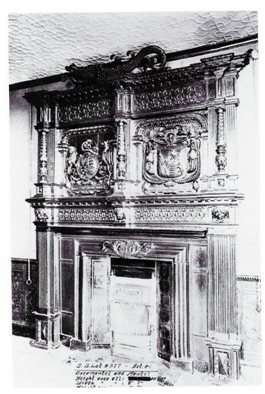 The Elizabethan "State Bedroom" in the Hall
The Elizabethan "State Bedroom" in the Hall
|
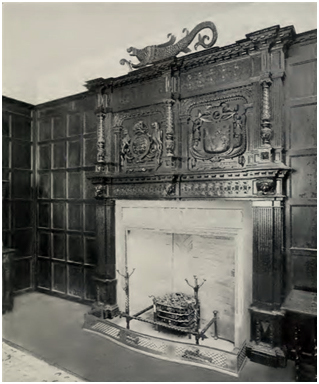 and in Robersons' showroom
and in Robersons' showroom
|
The Drawing Room and Study were originally from Borwick Hall near Carnforth. They were moved to Standish following the marriage of William Standish to Cecilia Bindloss the heiress of Borwick Hall. They were probably moved to Standish when William inherited the manor in 1682.
So, who would have the wealth to buy these rooms with a unique place in history? The Old Drawing Room (James I Room) and the Study (State Bedroom) were bought by one of the wealthiest and best-known men in America, William Randolph Hearst.
Hearst had amassed huge personal wealth as a media magnate. He was one of the richest and most powerful men in America,and a prolific collector. Many acquisitions were stored away, others were used to furnish the castle he was building in California known as San Simeon. His life was controversially depicted by Orson Wells in the Oscar winning movie Citizen Kane.
The rooms were shipped to his four-storey warehouse in the Bronx, New York. A few years later the great depression of the 1930s put an end to Robersons' trade. They closed their show rooms and a fire destroyed their sales records. Even Hearst faced bankruptcy. He was forced to sell many of his treasures, but was able to keep some, whilst others were placed in the hands of the Hearst Foundation.
The two rooms next appear in the catalogue for the "Hearst Sale" of 1940/41. To his humiliation his close rival in the art world, Armand Hammer, took ownership of much of his collection and organised a huge sale using the two-acre fifth floor of Gimbels Department store in New York. Hammer was the Chairman of Occidental Oil and like Hearst used his wealth to acquire art.
The timing of the sale was unfortunate. World War 2 was escalating and there was low interest in the sale. The Study(State Bedroom)did not sell and became the property of the Hearst Foundation. It next appears when it is donated by the Foundation to the Detroit Institute of Arts (DIA) in 1958. It remains there in storage to this day. It was valued at $27,500 in 1958 which would equate to around a quarter of a million dollars in 2019.The Old Drawing Room however did attract a buyer in 1941.
Anton (Tony) Hulman was from a wealthy family in Terre Haute, Indiana. They made their wealth in the wholesale grocery trade. Tony was building a lakeside lodge in Terre Haute, and bought the room as the main feature. He became a household name in the USA when he restored the Indianapolis Racing Circuit after WW2 and revived the famous Indianapolis 500. He was a modest man but became known for starting the race each year with the iconic words "gentlemen start your engines". He installed the room in "Lingen Lodge" named after the town in Germany where his grandfather was born.
Tony was pictured in front of the fireplace with his wife Mary in a local newspaper article in 1977. He sadly died a few months later. Mary continued Tony's philanthropic work supporting the arts, education, and sport in the city and surrounding area.
They were benefactors of the Rose-Hulman Institute of Technology in the city. The lodge and surrounding parkland remained in the family until it was sold to the Institute in 2017. The lodge is used as a resource for the college and to host conferences and meetings. The Old Drawing Room is still intact and well cared for. It is known as the "Myles Standish Room" and the college president has taken a keen interest in its history. He has kindly supplied photographs which provide stunning detail of the 400-year-old carved woodwork.
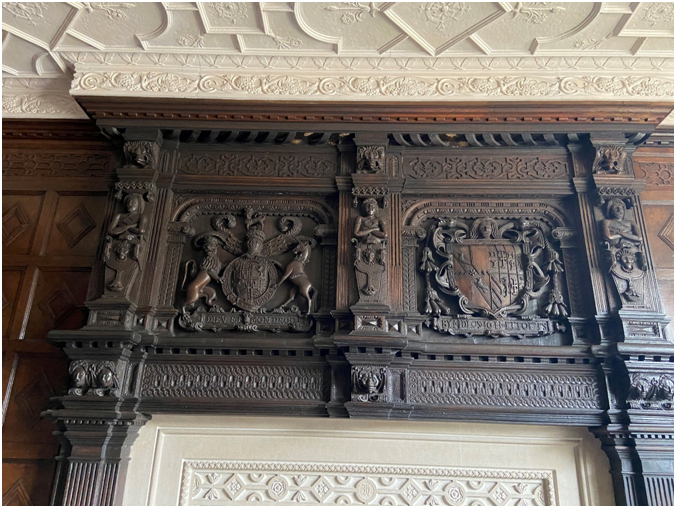 Jacobean Chimneypiece from the "Old Drawing Room" (now known as the Myles Standish room)
Jacobean Chimneypiece from the "Old Drawing Room" (now known as the Myles Standish room)
in The Hulman Lodge, Terre Haute, Indiana, USA
|
The Oak Library was sold by Robersons in 1922 to Ralph Harman Booth of Detroit, Michigan who was building a house at Grosse Pointe. Like Hearst he was a publisher but also had interests in banking. The house has changed hands over the years but is still known as the Ralph Harman Booth House. When up for sale in 2019 the description of the interior included the following: "Amongst many of the superb architectural details is the libraries' fireplace, and walnut panelling from Standish Hall". However, we know the Library from Standish Hall was oak.
This must be the same room Norman Standish described visiting in 1987. There is a photograph of Ralph's widow, Mary, standing in a room in the 1940s, which appears to match the Standish Hall Library. The fireplace sold by Robersons with the room had the distinctive arms of Ralph and Mary Standish carved into the stone hearth. So, any sight of the room should be conclusive. Robersons fitted out several rooms on two floors of the house so it is possible the oak library panelling has been used elsewhere in the house.
Ralph Booth was a lifetime patron of the arts. He founded the Detroit Arts Commission and later the Detroit Institute of Arts (DIA). He donated much of his personal collection to the DIA and the National Gallery in Washington. He died in Europe in 1931 while serving as the US envoy to Denmark. Mary continued to live at Grosse Pointe where she died in 1951.
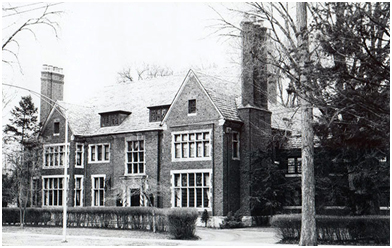 The Ralph Harmon Booth House
The Ralph Harmon Booth House
|
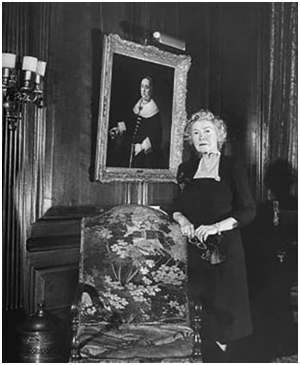 Mary Booth in the "Oak Library"
Mary Booth in the "Oak Library"
|
So, by an incredible coincidence two rooms from Standish ended up in Detroit less than ten miles apart. One donated to the DIA by the Hearst Foundation and the other in a house built by one of the DIA's major benefactors.
The "Dining Room" was bought in 1924 by Tryphena Gunn Mitchell. She was an American living in England. She had met and married William Nelson Mitchell following a family visit to Bristol. He was a senior executive with the Imperial Tobacco Co. They bought Halsway Manor in Somerset in the early 1920s and Tryphena was sympathetically refitting the interior. She was obviously keen to have it as she had to raise the ceiling and floor above so that it could be installed.
Halsway remained the family home until William died in 1936 when Tryphena moved to a smaller house in Bath. Her only son was killed during WW2 and she later returned to her family in Indiana USA. She died in California in 1971 aged 94. She was reunited with her husband when her ashes were buried alongside him in the local church near Halsway Manor.
The Manor changed hands a number of times before it was sold to become the National Centre for Folk Arts. Since then it has provided a residential setting for practicing and promoting folk arts. The Dining Room from Standish remains intact and is often filled with people of all ages practicing and performing music and folk art.
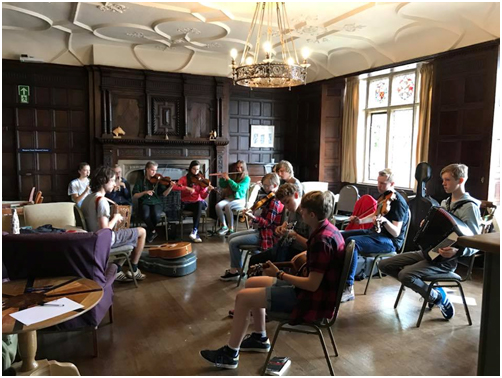 Young musicians using the "Dining Room" in Halsway Manor, Somerset
Young musicians using the "Dining Room" in Halsway Manor, Somerset
|
So, we have found all four rooms from Standish Hall. Does this solve the mystery? Was it the dismantling and removal of the rooms and their reassembly in America that created the belief that the Hall had been rebuilt in the States? I have not found any contemporary reports of the Tudor wing and Chapel being taken to America, and no trace of the Hall's exterior has ever been found there. Perhaps the story helped soften the blow of the precious parts of the Hall being lost, or perhaps like most myths the story grew and evolved in the retelling.
Of the four rooms we know two are linked to Detroit and the Institute of Arts, but the other two rooms also retain a link. They are both connected to Terre Haute in Indiana. The Old Drawing Room was bought by one of its most famous sons, Tony Hulman. When he died in 1977 his widow Mary Fendrich Hulman took over his position and continued as a benefactor to the city. She grew up in Terre Haute and attended Saint Mary-of-the-Woods College and became a long-term patron. The Dining room that is now in Halsway Manor was bought by Tryphena Gunn Mitchell. She was born and brought up in Indiana and incredibly also attended Saint Mary-of-the-Woods College. She maintained contact with the college and contributed to it all her life. Over 20 years separated their time there, but I cannot help wondering if they ever met, or if they knew they both owned precious rooms that were part of Standish Hall centuries earlier.
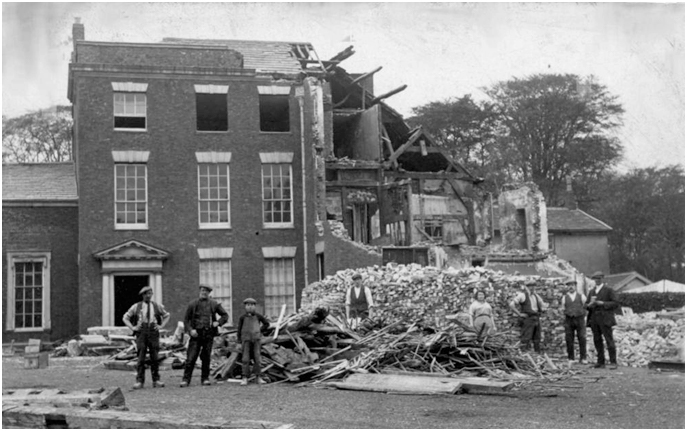 The Tudor Hall and Chapel being demolished in 1923. The valuable wood panelled rooms had been removed The Tudor Hall and Chapel being demolished in 1923. The valuable wood panelled rooms had been removed |
|